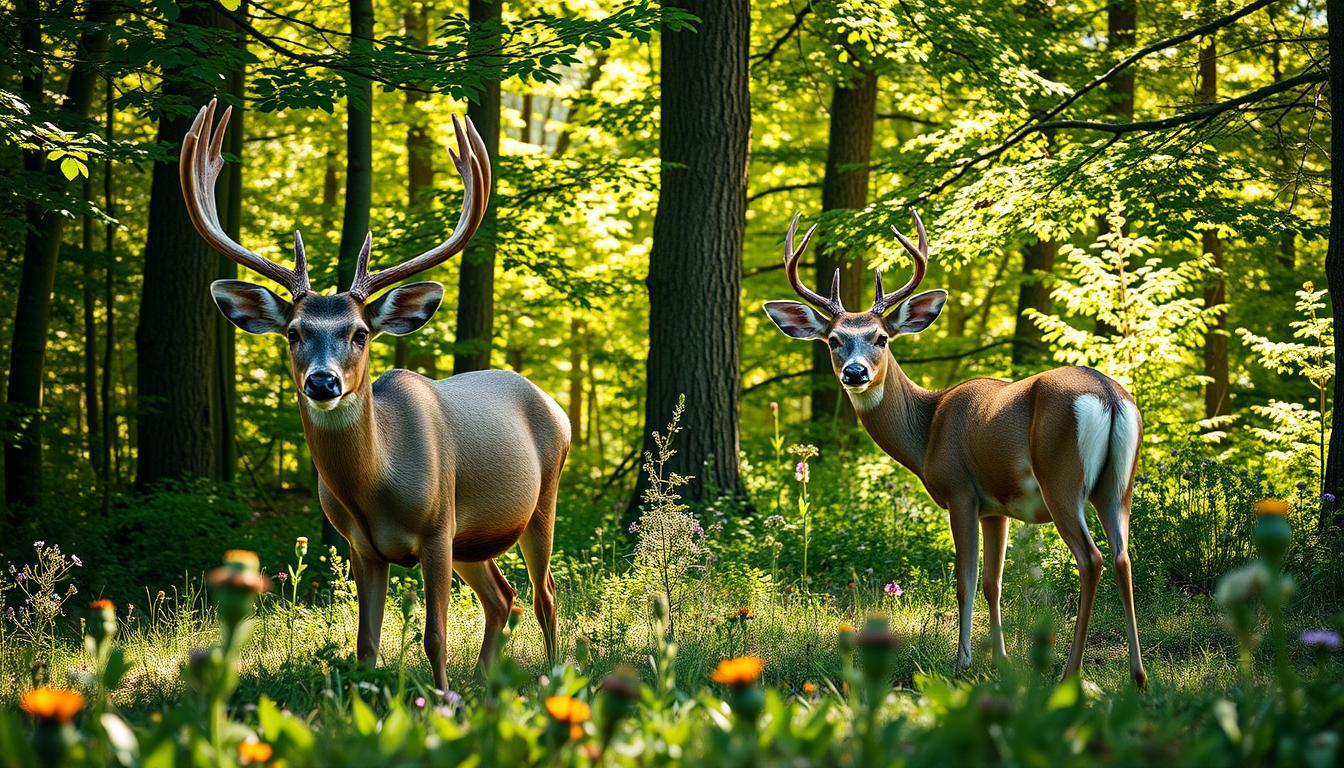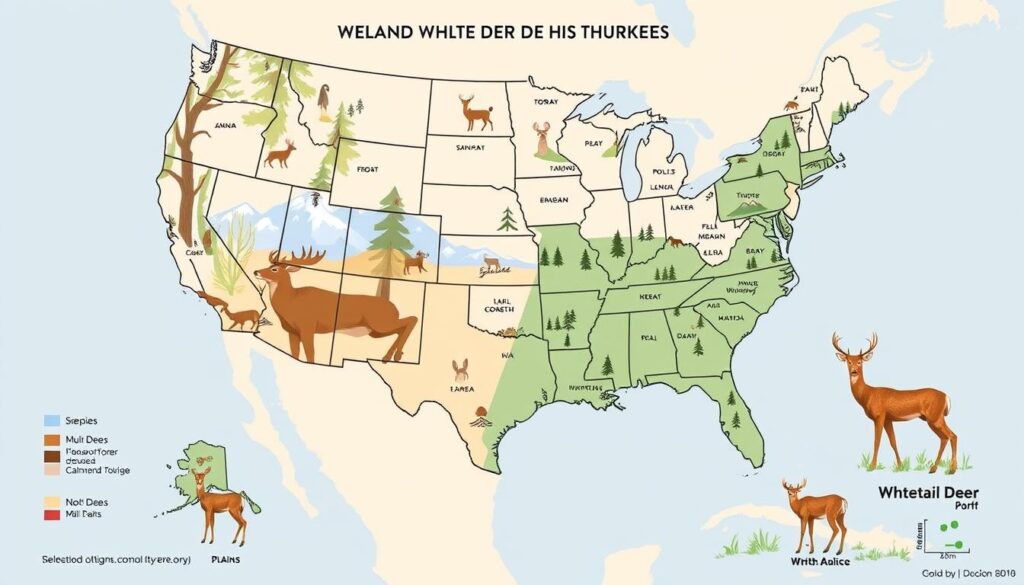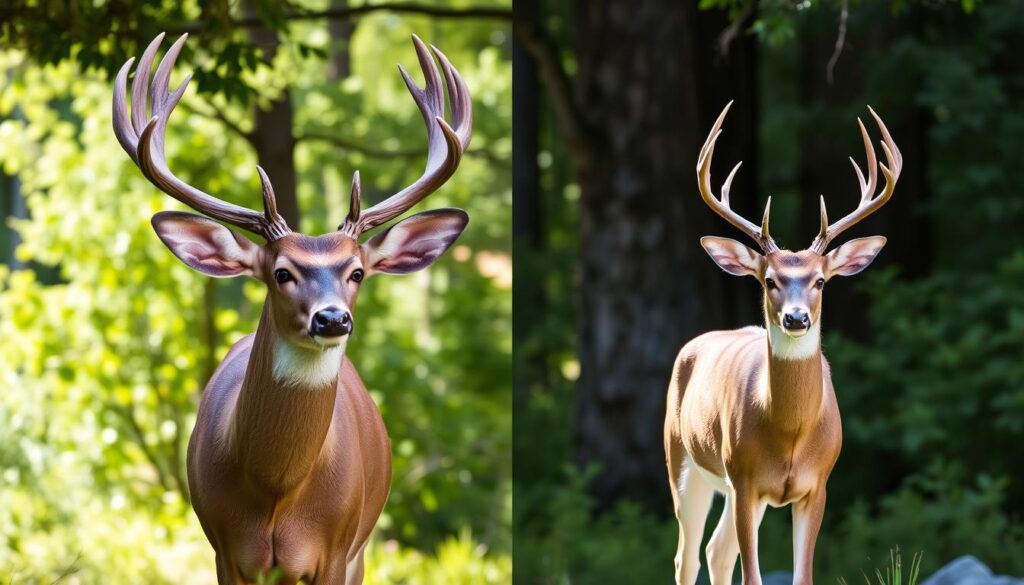Mule Deer vs Whitetail Deer: Key Differences

Did you know mule deer can weigh up to 450 pounds? The largest white-tailed deer rarely hit 400 pounds. This shows how different these two deer species are in the United States1. Knowing the differences between mule deer and whitetail deer is key for wildlife lovers and hunters. It’s also interesting for anyone who loves nature and wildlife.
We’ll look at their unique traits, behaviors, and homes. This will give us a full view of how they differ. From size and antlers to mating habits and where they live, learning about mule deer vs whitetail deer is fascinating.
Key Takeaways
- Mule deer generally weigh more than whitetail deer, with some topping 450 pounds.
- White-tailed deer have a higher birth rate than mule deer.
- Mule deer and whitetail deer have distinct antler shapes.
- Understanding behavior differences helps in wildlife observation and hunting.
- Mule deer mate from mid- to late-November, while whitetails breed later in the year.
Introduction to Deer Species Comparison
Knowing the differences between deer species is key for both fans and hunters. Mule deer and whitetail deer have unique traits that shape their lives and habitats. Mule deer usually weigh between 125-300 lbs and are about 3.3 feet tall2. They live in western North America, from Alaska to southern Baja Mexico, and the Western Great Plains to Canada2. Understanding these traits helps us appreciate wildlife in different places.
Whitetail deer prefer denser brush, sometimes living in the same areas as mule deer. Mule deer can grow up to 6.5 feet long and weigh 175 to 200 pounds. White-tailed bucks are 6 to 7 feet long and weigh 90 to 210 pounds3. This comparison guides hunting and shows respect for their ecosystems.
Being able to tell these deer apart is very important, especially where they live together. Knowing their behaviors helps make hunting safer and more respectful.
Mule Deer Characteristics
Mule deer (Odocoileus hemionus) have unique features that make them stand out. Their large ears are like a mule’s, helping them hear sounds well4. They weigh between 125 and 250 pounds, with some being even bigger5. Their coats are grayish-brown, with white rumps that are more noticeable than those of whitetail deer6.
Mule deer have complex antlers that often split and have many tines. This is different from whitetail deer, which have simpler antlers5. They also have a special way of escaping called “stotting,” where they jump high on all four feet. This is not seen in whitetail deer5.
Knowing about mule deer helps us understand their behavior and how they adapt. It’s also good for outdoor lovers to know. If you’re going out and want to make sure your pet is safe, check out this guide on dog boarding facilities to get ready for your trip.
Whitetail Deer Habits
Whitetail deer are very adaptable and live in many places in the U.S., Mexico, and Canada. They eat grasses, leaves, fruits, and nuts. This variety in their diet helps them survive by changing with the seasons.
In summer, they eat tender shoots and berries. In winter, they eat twigs and bark. Knowing these changes is key for hunters and wildlife lovers.
The whitetail deer lifecycle includes unique breeding habits. Males start rutting in fall to attract females. Females can breed at six months and have babies after about six and a half months. This quick breeding helps their numbers grow, with 30 million in the U.S. and 3.6 million in Texas7.
Whitetail deer are quick and alert. They use their white tails to warn others when they sense danger. This is important for their survival, especially where humans and deer live together. For more on whitetail and mule deer, read this article on deer hunting differences.
Understanding whitetail deer habits shows how complex their behavior and habitat needs are. It helps us see how they thrive in both wild and suburban areas8.
Key Physical Differences
When we look at mule deer and whitetail deer, we see clear differences. These differences are especially true in their antlers and tails. Knowing these differences helps us appreciate these amazing animals more.
Antler Structure
Mule deer and whitetail deer have different antlers. Mule deer have antlers that split into two branches with smaller brow tines. Whitetail deer have antlers with bigger brow tines and a straighter main beam. These differences make each species look unique and show how they adapt to their surroundings.
One special thing about mule deer antlers is how they branch out. This can change based on where they live and their genes. There are over 36 million of these deer in the United States. This shows how common they are and how they adapt to different places910.
Ears and Tail Characteristics
The ears of mule deer and whitetail deer are also different. Mule deer have longer, more pointed ears. Whitetail deer have shorter, rounder ears910. Looking at their tails, mule deer have a white rump and a black-tipped tail. Whitetail deer have a brown body and a hidden white tail.
This difference in tail visibility is important for signaling and communication. It helps them warn others of danger. These physical traits tell us a lot about their behavior and where they like to live. They also make each species stand out in the deer family.
| Characteristic | Mule Deer | Whitetail Deer |
|---|---|---|
| Antler Structure | Bifurcated, minimal brow tines | Upright, prominent brow tines |
| Ears | Longer and pointed | Shorter and rounded |
| Tail | Fluffy white with a black tip | Brownish body with a concealed white tail |
These differences are key for understanding deer species. They also help improve your skills in observing wildlife9.
Deer Behavior Contrast
Knowing how mule deer and whitetail deer behave is key for wildlife fans and hunters. They move and eat in different ways, making them easy to spot in the wild.
Movement Patterns
Mule deer are known for their stiff-legged bounding. This makes their movement stand out. Whitetail deer, on the other hand, move with a smooth gallop.
Mule deer have big ears, like a mule’s, which help them hear well. They roam in various terrains. Mule deer usually weigh between 100 and 220 pounds. Whitetail bucks are slightly smaller, averaging around 150 pounds1112.
Feeding Habits
Whitetail deer eat a wide variety of plants, showing they can live in many places. They enjoy forests, farmlands, and grasslands. Mule deer, however, prefer to eat certain shrubs and forbs in western North America.
Understanding these feeding habits helps hunters plan better hunting trips. It’s all about knowing how each deer species behaves.
| Criteria | Mule Deer | Whitetail Deer |
|---|---|---|
| Movement Style | Stiff-legged bounding | Fluid galloping |
| Average Weight | 100-220 lbs | 90-200 lbs |
| Feeding Adaptability | Selective browsers | Adaptable to various plants |
| Plant Species Consumed | Varies, specific to habitat | Approximately 600 species |
| Habitat Range | Western North America | Widespread across North America |
Geographical Distribution of Mule Deer vs Whitetail Deer

Mule deer live mainly in western North America. They are found from Alaska’s coastal islands to California’s southern Pacific Coast. They also go as far south as Baja Mexico and Zacatecas in northern Mexico13.
Their homes are in open, mountainous areas. These places have lots of grass and shrubs13. Mule deer need these areas because they can grow up to 200 pounds for males and 150 pounds for females. They need places to eat and move around seasonally14.
Whitetail deer, however, live in more places across the United States. They like woodlands, fields, and even cities. They are more common, with about 6 million being hunted each year compared to 240,000 mule deer14. This shows they can live in many different places.
The way these deer live in different places affects their numbers and how we protect them. Mule deer face challenges like losing their homes and competing with others. But many whitetail deer are doing well in different places13.Knowing these differences helps hunters and those who want to save deer populations.
Deer Hunting Differences
Knowing the deer hunting differences between mule deer and whitetail deer can really help you succeed. Hunting mule deer often takes place in open areas. This means hunters need to adjust their methods to cover more ground.
This open landscape is perfect for long-range shooting and sneaky approaches. Mule deer are generally more calm around hunters. They are less likely to get scared easily compared to whitetails15.
Hunting whitetail deer, on the other hand, happens in wooded areas. Here, hunters must use different tactics because of the deer’s aggressive nature. They often use still hunting or blinds to hide well.
The type of habitat also matters. Whitetail deer have heart-shaped tracks, while mule deer tracks are bigger and more oval16.
Hunting seasons and licenses can change by state, affecting your plans. It’s important to know the local rules for a legal and safe hunt. Doing your homework can improve your hunting skills in your preferred setting. For more tips, check out this useful guide.
Deer Species Identification Tips

Knowing how to tell mule deer from whitetail deer can make your outdoor adventures better. It’s key to know what to look for. Start by checking the ears; mule deer have bigger, longer ears with a dark edge. Whitetail ears are smaller and rounder17.
The tail shape and size also help identify them. Mule deer have a white rump and a short tail with a black tuft. Whitetail deer have a longer, flag-like tail that’s all white17.
Antlers are another clue. Mule deer antlers grow up and are more split. Whitetail antlers are lighter, straighter, and more even. Knowing this can help you spot mule deer1.
Facial markings are also important. Mule deer have lighter fur on their faces. Whitetail deer have light fur rings around their eyes and nose on a darker face17.
Watching how they move can also help. Mule deer move in a more uneven way. Whitetail deer move faster and more smoothly1.
For more tips on identifying deer, check out whitetail identification tips online. They can help you get better at spotting these amazing animals.
Conclusion
When we compare mule deer and whitetail deer, we learn a lot about hunting and wildlife. There are about 36 million deer in the U.S., and they often live in the same places18. Mule deer like clean, high places, while whitetails can live near people and farms19.
Each deer type has its own way of living and hunting. Whitetails eat crops, while mule deer prefer plants like shrubs19. Knowing these differences helps hunters plan better. Also, knowing how deer move and act during certain times is key for hunting success19.
As you spend more time outdoors, you’ll learn to love these deer even more. Whether you’re hunting mule deer in mountains or watching whitetail deer, each experience is special. Check out this article for more tips on hunting and enjoying deer19.
FAQ
What are the main differences between mule deer and whitetail deer?
Where do mule deer and whitetail deer typically live?
How do the feeding behaviors differ between mule deer and whitetail deer?
What hunting strategies should I use for mule deer compared to whitetail deer?
How can I identify mule deer and whitetail deer in the wild?
Do mule deer and whitetail deer have different breeding patterns?
Are there specific regulations for hunting mule deer vs whitetail deer?
Source Links
- A QUICK GUIDE TO DIFFERENTIATE MULE DEER FROM WHITE-TAILED DEER – Colorado Outdoors Online – https://coloradooutdoorsmag.com/2015/03/18/a-quick-guide-to-differentiate-mule-deer-from-white-tailed-deer/
- Mule Deer Facts – https://muledeer.org/mule-deer-black-tailed-facts-biology/?srsltid=AfmBOoqwc2svxwm46GsaZysPnpfBAANtXJmL_ozwrMcO0e5d8LOZm14p
- Mule Deer – Discover Lewis & Clark – https://lewis-clark.org/sciences/mammals/deer/mule-deer/
- 8 Major Differences Between Whitetails and Mule Deer – https://realtree.com/deer-hunting/articles/8-major-differences-between-whitetails-and-mule-deer?srsltid=AfmBOopvyfWBVLlveDUEoD2v7sk0thLImP7GdDviVMQLHvsW0CyGJeoW
- Mule Deer vs Whitetail | Field & Stream – https://www.fieldandstream.com/hunting/mule-deer-vs-whitetail
- The Difference Between Mule Deer vs. Whitetail Deer – https://huntwise.com/field-guide/deer/how-to-tell-the-difference-between-mule-deer-vs-whitetail-deer
- Mule Deer vs. Whitetails: A Species Comparison – https://www.themeateater.com/wired-to-hunt/whitetail-management/whitetails-and-mulies-a-comparison
- Hunting Whitetail vs. Mule Deer – https://montanadecoy.com/blog/hunting-whitetail-vs-mule-deer/
- Mule Deer vs. White-tail Deer: Differences, Similarities, and How to Tell Them Apart – https://www.completeguidetoarchery.com/mule-deer-vs-white-tail-deer-differences-similarities-and-how-to-tell-them-apart/
- Hunting Mule Deer vs Whitetail – https://skregear.com/blogs/mule-deer-hunting/hunting-mule-deer-vs-whitetail?srsltid=AfmBOopDRnM9GuBhzayOUeK3PoO1O1R30tF79aT_xxUZ6CBMDGyL46O3
- Animal Identification: Mule Deer vs Whitetail – https://www.ilearntohunt.com/blog/animal-identification-mule-deer-vs-whitetail/
- Mule Deer vs Whitetail Deer: Guide to Telling the Two Apart – https://blog.carbontv.com/2024/06/07/mule-deer-vs-whitetail-deer/
- Mule Deer Facts – https://muledeer.org/mule-deer-black-tailed-facts-biology/?srsltid=AfmBOooQSFR9-El1ymm4P8GXiogRoIlnPEBBIFTxE4t_KcsQYLPqXJmT
- Meet the Mule Deer, Western Cousin of the Whitetail – https://deerassociation.com/meet-the-mule-deer-western-cousin-of-the-whitetail/
- 8 Major Differences Between Whitetails and Mule Deer – https://realtree.com/deer-hunting/articles/8-major-differences-between-whitetails-and-mule-deer?srsltid=AfmBOoquwvldLcGKd_UZ_AMldHeH6iZ4INgvG_u2DCnZQt4nhhJeGfq7
- From Whitetails to Mule Deer – https://www.findahunt.com/differentiating-deer-tracks-from-whitetails-to-mule-deer
- Mule Deer vs. Whitetail Deer: How to Tell Them Apart – https://www.outdoorlife.com/conservation/mule-deer-vs-whitetails/
- Hunting Mule Deer vs Whitetail – https://skregear.com/blogs/mule-deer-hunting/hunting-mule-deer-vs-whitetail?srsltid=AfmBOooFvhF7qQEMdyiWCblptScCYxpnQuAueCMb_oCO8u4zgy5l9jU7
- Mule Deer Vs Whitetail Deer: The Ultimate Showdown – https://www.survivalresources.com/tryecho20/mule-deer-vs-whitetail-deer.html



